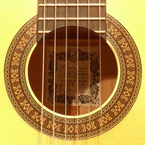Welcome to one of the most active flamenco sites on the Internet. Guests can read most posts but if you want to participate click here to register.
This site is dedicated to the memory of Paco de Lucía, Ron Mitchell, Guy Williams, Linda Elvira, Philip John Lee, Craig Eros, Ben Woods, David Serva and Tom Blackshear who went ahead of us.
We receive 12,200 visitors a month from 200 countries and 1.7 million page impressions a year. To advertise on this site please contact us.
|

|
|
RE: sticking points for speed
|
You are logged in as Guest
|
|
Users viewing this topic: none
|
|
Login  | |
|

   
Grisha
Posts: 1263
Joined: Mar. 17 2005

|
 RE: sticking points for speed (in reply to el ted) RE: sticking points for speed (in reply to el ted)
|
|
|
Damn it! I just lost my essay! 
A few points, then.
Higher tension string bounces less, so you have more control. But it is also harder for the finger to move it. If you play same speed scales on both tension strings, it will take more effort to play high tension. That means you'll run out of juice sooner at higher velocities. Speed is proportional to power used. So you will reach your power limit at a somewhat lower speed. Think of hard tension strings as a downforce device on a race car. It may give you more stability, but takes away the top end.
There are more things at play here. Action is as important as strings tension. The lower the action, tho looser the strings, right? So, less speed. With a higher action your left hand fingers have to push the string a greater distance to play in closed position. So, less speed. Fingernails. The shorter the distance your nail has to travel in contact with the string the less time will be waisted, giving you more speed. Nail thickness. The wider contact area with the string the more friction, so less speed. Power. When you play harder, string moves more, so there you have your lower tension string effect. And let's not forget the position of your right hand in relation to sound hole and bridge. Different, as night and day.
Interesting thought here. By sliding your right hand from sound hole to the bridge you may find the perfect resistance on both normal and high tension strings. But on lower tension strings it will be much closer to the bridge. And the problem with that is that your m finger will experience much greater resistance than i finger. On high tension strings and closer to the sound hole the resistance for both fingers will be more equal.
I said it all so much better in that essay.... damn...
I would say that for each one of us there is this one perfect tension that FEELS the best. The one we know best how to deal with. Like the drive from work to home.
P.S. Sorry, Ron.
P.P.S. Maybe what I am trying to say is that a lot of these factors are cancelling each other out when you start to vary them. So the key to fast picado is your ability to sense and adjust.
_____________________________
|
|
|
|
REPORT THIS POST AS INAPPROPRIATE |
Date Jul. 23 2006 15:16:23
 |
|

   
Miguel de Maria
Posts: 3532
Joined: Oct. 20 2003
From: Phoenix, AZ

|
 RE: sticking points for speed (in reply to Doitsujin) RE: sticking points for speed (in reply to Doitsujin)
|
|
|
Okay, to take a new tact... Grisha has proven that he can still execute the technique on a severely modified guitar. He told us he can play ANY guitar (and I believe him). This is highly different from my current situation.
My guitar has high or normal tension strings, low action, and a very nice feel to it. Whe I play other guitars, my performance is very much downgraded. For example, my friend plays an Ovation with extra high tension strings. The moment I pick that guitar up, I put it right back down. Yeech! I can't play it, it feels like reaching inside a piano.
I think most of us that are trying to play decently complicated things find that string tension does matter. I wonder if that points the fact that we're just not that good, or does it mean there's something specific we should be working on?
Lately I've realized an important point: you have to be able to control the moment of release of the RH note, and you have to be able to synchronize the action of playing RH and LH exactly.
Going further, if you are going to play fast, you need to be able to touch the string and release it in an instant, an instant you can control, and then relax. I know of no other way to play at speed.
So, we could see string tension interfering with this in a few ways:
1. needing more strength to release string
2. rubbery feeling somehow "sticking" on finger
3. increasing strength/time needed to push down LH
It seems to me that someone like Grisha is able to adjust to these factors, through experience and greater sensitivity (he is a very sensitive guy--I bought his album and he looks very sensitive on it :)). It might be a good exercise for regular guys to look at these factors and see how much of it we can counteract through a little use of the mind.
When I play over the hole, my string can easily pass through with no effort, but as I move toward the bridge, it begins to "catch". Part of this is because my fingernail may not be attacking the string properly. It may be at an angle that will _pull_ the string. Think, it is only a tiny light piece of nylon, but if you _pull_ on it, you could probably lift the whole guitar. But if you find a way to _slide_ through it, you can do it with much less strength. A low tension string will let you get away with less strength or a less than perfect angle. A higher tension string will make you work real hard, especially until you examine the problem and refine your attack. I hypothesize that not only does Grisha have a perfect attack, he is strong. So, no problem.
The problems with low tension strings are a little harder to analyze. Probably one of them is that eventually, your fingers will catch if you are not using a perfect attack. It is fine until you try to go fast, when this problem "catches up" to you. Another is that you are just not used to it. If you are always relying on that tension, it woudl take time to adjust to a more floppy feeling. You might find yourself adjusting your hand position or attack slightly.
As far as the LH goes, a higher tension string makes it harder to push down. So you need to have the ability to exert more force in the same amount of time. This seems to me to be a strength issue. Recall that as the task gets harder, we tend to use more and larger muscles. A light touch with one finger can easily be done, but a powerful blow calls upon the whole arm or body. This is natural, but lessens independence among the fingers. The prescription for this, it would seem would be gradual strengthening of the fingers individually through lots of slurs or perhaps playing on a high-action guitar while respecting the independent action of the fingers.
To those who are still reading, I would like to reiterate that I think it's important for the RH to be able to play a note in an instant, any instant. If you can gain enough control without clenching up your hand, the speed will easily follow once your mind can think the notes.
_____________________________
Connect with me on Facebook, all the cool kids are doing it.
https://www.facebook.com/migueldemariaZ
Arizona Wedding Music Guitar
|
|
|
|
REPORT THIS POST AS INAPPROPRIATE |
Date Jul. 23 2006 15:24:13
 |
|

   
Exitao
Posts: 907
Joined: Mar. 13 2006
From: Vancouver, Canada

|
 RE: sticking points for speed (in reply to Miguel de Maria) RE: sticking points for speed (in reply to Miguel de Maria)
|
|
|
quote:
To those who are still reading, I would like to reiterate that I think it's important for the RH to be able to play a note in an instant, any instant. If you can gain enough control without clenching up your hand, the speed will easily follow once your mind can think the notes.
Very readable. Good writing.
The more I read this type of thing in this forum the more I begin to see similarities to sports sciences:
Explosive anaerobic actions require generally relaxed body parts followed by explosive speed.
However, endurance is also a factor as Grisha points out. So there is a need for exercises to increase this.
So there is a need for speed training and endurance training. The formula for endurance training seems easy, repetition. Scales, practise pieces which are repetitive, our friend's picado scales, etc.
You could even mix it up and use this exercises to help build speed by taking a lesson from runners by doing interval training, normal speed scales interrupted by periods of your current max speed followed by a return to the normal practise speed.
Other than exercises that isolate fingers and movements (like our other friends reverse rasgeo which he says has increased his power), how to build for strength?
|
|
|
|
REPORT THIS POST AS INAPPROPRIATE |
Date Jul. 23 2006 17:10:54
 |
|
 New Messages New Messages |
 No New Messages No New Messages |
 Hot Topic w/ New Messages Hot Topic w/ New Messages |
 Hot Topic w/o New Messages Hot Topic w/o New Messages |
 Locked w/ New Messages Locked w/ New Messages |
 Locked w/o New Messages Locked w/o New Messages |
|
 Post New Thread
Post New Thread
 Reply to Message
Reply to Message
 Post New Poll
Post New Poll
 Submit Vote
Submit Vote
 Delete My Own Post
Delete My Own Post
 Delete My Own Thread
Delete My Own Thread
 Rate Posts
Rate Posts
|
|
|
Forum Software powered by ASP Playground Advanced Edition 2.0.5
Copyright © 2000 - 2003 ASPPlayground.NET |
0.09375 secs.
|


 Printable Version
Printable Version










 New Messages
New Messages No New Messages
No New Messages Hot Topic w/ New Messages
Hot Topic w/ New Messages Hot Topic w/o New Messages
Hot Topic w/o New Messages Locked w/ New Messages
Locked w/ New Messages Locked w/o New Messages
Locked w/o New Messages Post New Thread
Post New Thread